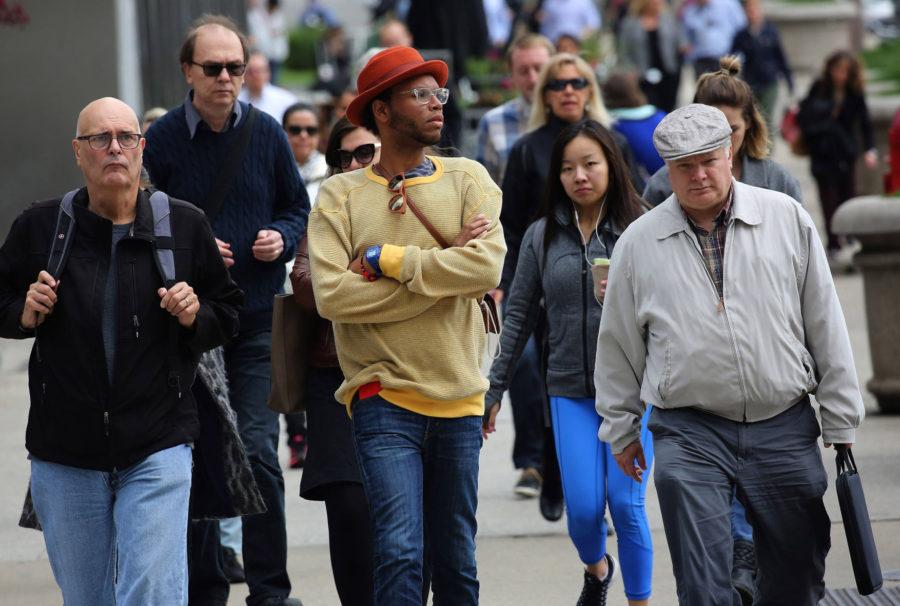Chicago losing population, could be overtaken by Houston as 3rd largest US city
May 19, 2016
Chicago, the only city among the nation’s 20 largest to see population loss in 2015, could be overtaken in a decade by Houston as the third-most-populous city if the trend continues, experts said.
The city of Chicago lost about 2,890 residents between 2014 and 2015, bringing the city’s population down to 2,720,546, according to newly released data from the U.S. Census Bureau. Numbers made available in March showed the greater Chicago area, which includes the city and suburbs and extends into Wisconsin and Indiana, lost an estimated 6,263 residents — the greatest loss of any metropolitan area in the country.
Chicago’s population decline is largely a product of residents fleeing both the city and state. The Chicago Tribune in March surveyed dozens of former residents who have left within the last five years, and each offered a list of reasons for leaving: high taxes, the state budget stalemate, crime, the unemployment rate and the weather.
Advertisement
Black residents have been among those calling it quits on their hometown. Propelling black flight is the search for safe neighborhoods and prosperity, with many African-Americans heading to the suburbs and warm-weather states. Chicago lost 181,000 black residents between 2000 and 2010, according to census data.
The population decline in the Chicago metropolitan area is the first since at least 1990, according to census data.
The nation’s fourth-most-populated city, Houston, saw the second-largest increase among major cities, gaining 40,032 residents between 2014 and 2015. While Houston’s population, about 2.3 million, is still about 424,000 residents behind Chicago, experts say that if the trends continue, Houston could eclipse Chicago’s population in about 10 years.
“That’s the trend,” said Rob Paral, a Chicago-based demographer. “Even if Chicago stays fairly steady for a period, Houston would pass us up in about 10 years. It’s not inconceivable.”
But William Frey, a demographer with the Brookings Institution who analyzes census data, said such 10-year projections are “crystal ball kinds of predictions,” as they cannot account for economic shifts. While Texas’ economy is thriving as a result of the oil and gas industries right now, there have been periods of volatility, he said.
The same could be said for Chicago, as it’s only the first year in several that the city’s population has dropped.
“It’s certainly possible,” Frey said, when asked about the likelihood of Houston becoming the country’s third-largest city. “If you project those [populations] out, then it’ll be close to 10 years before there’s a convergence. But that’s not likely to be the case.”
Advertisement*
The populations of major cities will always fluctuate, said University of Chicago economist Allen Sanderson. He noted that a century ago, New York, Philadelphia and Chicago were among the country’s 10 largest cities and that they are the only ones that remain on that list today.
Texas’ population as a whole is soaring, and the Census Bureau placed five Texas cities on its list of major cities with the largest population increases, and another five on its list of fastest-growing U.S. cities. It reflects how residents across the Midwest are flocking to Sun Belt states, such as Nevada, Arizona and Florida.
During the years after the economic recession of the mid-2000s, migration to those states slowed, but it’s heated up again as states in the South and West have greater job opportunities and affordable housing.
The entire Midwest has been losing residents, census data show. While Illinois’ population dropped by 7,391 in 2014, that number more than tripled from 2014 to 2015 — to 22,194. Other Midwestern cities, like Detroit and Milwaukee, have dipped in population. Detroit lost 3,107 residents from 2014 to 2015, and Milwaukee lost 443.
Experts say the main factors in Chicago’s population dip are the exodus of African-Americans and the aging of the Mexican immigrant population. More than any other city, Chicago has depended on Mexican immigrants to balance the sluggish growth of its native-born population, said Paral, the Chicago demographer. During the 1990s, immigration accounted for most of Chicago’s population growth.
But after 2007, falling Mexican-born populations became a trend across the country’s major metropolitan areas. Most of those cities were able to make up for the loss with the growth of their native populations, but Chicago couldn’t.
Liz Schuh, principal policy analyst with the Chicago Metropolitan Agency for Planning, said that while the population decline is small, it’s concerning. She said the numbers reflect the region’s economy, which is being affected by the Illinois budget stalemate. The impasse in Springfield could scare off businesses looking to invest in Chicago.
Chicago also has been slow to recover from the recession, and when areas aren’t experiencing job growth, people are hesitant to move there, she said.
Shawn Delk, a 42-year-old chiropractor who lived in Chicago for more than 12 years, moved to Houston in February after spending two years wrestling with the idea of leaving the city he grew to love.
He has a long list of reasons for leaving: rising rent prices, crumbling infrastructure, parking rules and tickets that take a bite out of the wallet, and high taxes.
“My friend and I were laughing about what the city’s going to tax next,” he said. “Walking on the sidewalk in the Loop, maybe? Is that a 2 percent tax?”
What made Delk seriously consider leaving Chicago, however, was that he believed crime was escalating. Despite being the nation’s third-most-populous city, Chicago outpaces New York City and Los Angeles in the number of homicides and shootings, though it fares better than some smaller cities in a per-capita comparison.
“Chicago will always be a home to me. And all of my friends who’ve left say the same thing. The electricity of the city in the summer is amazing, the soul of the city is within Chicagoans,” he said. “But there comes a point where problems begin to grow so large that you can’t ignore them anymore.”
(c)2016 Chicago Tribune
Visit the Chicago Tribune at www.chicagotribune.com
Distributed by Tribune Content Agency, LLC.
Advertisement








